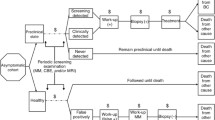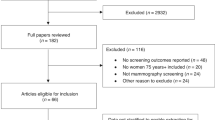Abstract
Purpose
During ongoing controversies about mammography screening, many investigators have stated that performance improvements in screening mammography may mitigate concerns about harms. However, there have been few attempts to quantify performance improvements required to recommend mammography screening. Based on USPSTF benchmarks, we utilized revealed preference methods to ascertain quantitative thresholds at which screening mammography would be recommended beyond biennial screening in women 50 and older.
Methods
Benefits of routine screening mammography (breast cancer deaths averted) were from published USPSTF meta-analyses. Potential harms (10-year cumulative probability of at least one false-positive) were from published Breast Cancer Surveillance Consortium estimates. We identified the implicit threshold (benefit/harm ratio) to recommend biennial screening starting at age 50. Using this threshold, we ascertained reductions of false-positives required to recommend more frequent screening and screening initiation under age 50 using revealed preference analyses.
Results
Using USPSTF implied benefit/harm ratio, routine biennial screening would be recommended starting at 40 if false-positives declined by at least 62%. Reductions of false-positive proportions of 74% would be required to recommend annual screening starting at 40 and reductions of false-positive proportions of 31% would be required to support annual screening starting at 50.
Conclusions
Using USPSTF revealed preferences, 31–74% reductions in false-positives would be required to recommend mammography screening beyond biennial screening starting at age 50. Widespread implementation of tomosynthesis and reducing recall rates to the lower end of recommended recall rates (5–12%) would provide support for expanding screening beyond biennial screening in women age 50.

Similar content being viewed by others
References
Fintelmann FJ, Bernheim A, Digumarthy SR, Lennes IT, Kalra MK, Gilman MD, Sharma A, Flores EJ, Muse VV, Shepard JA (2015) The 10 pillars of lung cancer screening: rationale and logistics of a lung cancer screening program. Radiographics 35(7):1893–1908
Elmore JG, Barton MB, Moceri VM, Polk S, Arena PJ, Fletcher SW (1998) Ten-year risk of false positive screening mammograms and clinical breast examinations. N Engl J Med 338(16):1089–1096
Welch HG, Black WC (2010) Overdiagnosis in cancer. J Natl Cancer Inst 102(9):605–613
Samuelson P (1937) A note on measurement of utility. Rev Econ Stud 4(2):155–161
Hubbard RA, Kerlikowske K, Flowers CI, Yankaskas BC, Zhu W, Miglioretti DL (2011) Cumulative probability of false-positive recall or biopsy recommendation after 10 years of screening mammography: a cohort study. Ann Intern Med 155(8):481–492
Siu AL, U.S. Preventive Services Task Force (2016) Screening for breast cancer: U.S. Preventive Services Task Force Recommendation Statement. Ann Intern Med 164(4):279–296
Nelson HD, Cantor A, Humphrey L, Fu R, Pappas M, Daeges M, Griffin J (2016) Screening for breast cancer: a systematic review to update the 2009 U.S. Preventive Services Task Force Recommendation [Internet]. Agency for Healthcare Research and Quality (US), Rockville
Carter SM, Barratt A (2017) What is overdiagnosis and why should we take it seriously in cancer screening? Public Health Res Pract 27(3):2731722
de Gelder R, Heijnsdijk EA, van Ravesteyn NT, Fracheboud J, Draisma G, de Koning HJ (2011) Interpreting overdiagnosis estimates in population-based mammography screening. Epidemiol Rev 33:111–121
Rosenberg RD, Yankaskas BC, Abraham LA, Sickles EA, Lehman CD, Geller BM, Carney PA, Kerlikowske K, Buist DS, Weaver DL, Barlow WE, Ballard-Barbash R (2006) Performance benchmarks for screening mammography. Radiology 241(1):55–66
Lehman CD, Arao RF, Sprague BL, Lee JM, Buist DS, Kerlikowske K, Henderson LM, Onega T, Tosteson AN, Rauscher GH, Miglioretti DL (2017) National performance benchmarks for modern screening digital mammography: update from the breast cancer surveillance consortium. Radiology 283(1):49–58
Smith-Bindman R, Chu PW, Miglioretti DL, Sickles EA, Blanks R, Ballard-Barbash R, Bobo JK, Lee NC, Wallis MG, Patnick J, Kerlikowske K (2003) Comparison of screening mammography in the United States and the United kingdom. JAMA 290(16):2129–2137
Mullen LA, Panigrahi B, Hollada J, Panigrahi B, Falomo ET, Harvey SC (2017) Strategies for decreasing screening mammography recall rates while maintaining performance metrics. Acad Radiol 24(12):1556–1560
Morris E, Feig SA, Drexler M, Lehman C (2015) Implications of overdiagnosis: impact on screening mammography practices. Popul Health Manag 18(Suppl 1):S3–S11
Bahl M, Gaffney S, McCarthy AM, Lowry KP, Dang PA, Lehman CD (2017) Breast cancer characteristics associated with 2D digital mammography versus digital breast tomosynthesis for screening-detected and interval cancers. Radiology 22:171148
Jochelson M (2014) Contrast-enhanced digital mammography. Radiol Clin North Am 52(3):609–616
Bahl M, Barzilay R, Yedidia AB, Locascio NJ, Yu L, Lehman CD (2017) High-risk breast lesions: a machine learning model to predict pathologic upgrade and reduce unnecessary surgical excision. Radiology 17:170549
Narayan A, Fischer A, Zhang Z, Woods R, Morris E, Harvey S (2017) Nationwide cross-sectional adherence to mammography screening guidelines: national behavioral risk factor surveillance system survey results. Breast Cancer Res Treat 164(3):719–725
Tosteson AN, Fryback DG, Hammond CS, Hanna LG, Grove MR, Brown M, Wang Q, Lindfors K, Pisano ED (2014) Consequences of false-positive screening mammograms. JAMA Intern Med 174(6):954–961
Arleo EK, Hendrick RE, Helvie MA, Sickles EA (2017) Comparison of recommendations for screening mammography using CISNET models. Cancer 123(19):3673–3680
Stapleton SM, Oseni TO, Bababekov YJ, Hung YC, Chang DC (2018) Race/ethnicity and age distribution of breast cancer diagnosis in the United States. JAMA Surg 153(6):594–595
Funding
This study did not receive any funding.
Author information
Authors and Affiliations
Corresponding author
Ethics declarations
Conflict of interest
CDL reports research support from General Electric and is on a health care advisory board for General Electric. The other authors declare no conflicts of interest.
Rights and permissions
About this article
Cite this article
Narayan, A.K., Elkin, E.B., Lehman, C.D. et al. Quantifying performance thresholds for recommending screening mammography: a revealed preference analysis of USPSTF guidelines. Breast Cancer Res Treat 172, 463–468 (2018). https://doi.org/10.1007/s10549-018-4917-5
Received:
Accepted:
Published:
Issue Date:
DOI: https://doi.org/10.1007/s10549-018-4917-5




